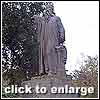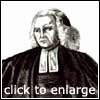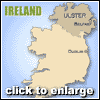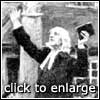
| PART FOUR: WHAT'S IN A NAME? Presbyterian, Covenanter, Seceder, Mountain Men, Burghers and Anti-Burghers, Old Lights, New Lights, Subscribing, Non-Subscribing By Brian Orr Have a question? Click Here to go to Brian's own Discussion Board!
Lets us begin with the basics: a covenant is defined as a mutual agreement between two or more people to do or refrain from doing certain things. Importantly, everybody in the covenant is consulted and agrees with the final terms. The Presbyterian belief was that they as individuals had a covenant with God and expected that their religion and agreements concerning it would be the subject of mutual agreement or covenant. The splinter groups that arose were due to internal disagreements about interpretations of faith or as a response to ongoing external pressures from the government of the day. These groups remained Presbyterian in structure but clung to their particular belief. There were very many changes in the make up of Presbyterianism from its beginnings with John Knox in 1560 into the 20th century. Presbyterians
Covenanters
The Covenanters were those Presbyterians with a concern for a strict faith and its management. They were signatories or adherents to the "National Covenant" of February 1638 which was a response to the King's attempts to change the style of worship of the Church which had not been previously approved (covenanted) by free assemblies and parliament.
In August, 1643, the Covenanters signed the "Solemn League and Covenant" which was a political treaty. Under this covenant the agreement was to impose Presbyterianism on England and Ireland. In return for this, the Covenanters agreed to support the English Parliamentarians against King Charles I in the Civil War that had broken out.
Seceders
Presbyterianism became the Established Church in Scotland in 1691 but there were still those who would not accept the settlement because it did not acknowledge the supreme sovreignty of Christ the King nor was it a 'covenanted' settlement. These Seceders or dissenters eventually became the Reformed Presbyterian Church.
In 1712, the Patronage Act reintroduced patronage as the means of appointing ministers thus repealing the earlier agreement of 1689. It also took away from the congregation its cherished right to choose its own minister There was also a trend towards liberalisation as Scotland turned more towards England for its political lead and with it, renewed theological conflict. Opposition to moderate moves were resisted with orthodoxy, subscription of the Confession of Faith and adherence to the National Covenant. Burghers and Anti- Burghers In 1733, the patronage issue finally caused dissenting congregations to form the Secession Church. The Associate Presbytery into which the Seceders formed themselves grew rapidly but the reintroduction of patronage and the taking of an oath created another split in the already divided Presbyterian church. On this occasion it was over the requirement to take an oath when elected to serve on town councils in Scottish burghs. Those prepared to tolerate this weakening in principle were called the Burghers and those against the change were the Anti- Burghers. Thus, in 1747 another split took place. New Light, Old Light
A second secession in 1752 saw another group - the Relief Church, come into being. The two groups of New Lights, who accepted the principle of moderate change eventually joined together in 1820 as the United Secession Church. The two groups of Old Lights finally joined together as the United Original Seceders in 1842.
In Ireland at the beginning of the 17th century all the churches and church lands belonged to the Church of Ireland. After 1615 the Church operated in a strong Calvinistic manner under the Fifteen Articles of Faith issued by James Usher, later Archbishop of Armagh. Yet, these were not forced upon a minister: Presbyterians and Church of Ireland congregations worshipped comfortably side by side for some 20 years.
But the Presbyterians suffered discrimination and persecution as did their brethren in Scotland for the rest of the 17th century. In the 1630s, the Bishops under Archbishop Laud sought to regain control and the Rev. Blair, Rev. Livingston and others were forced to go back to Scotland. The general populace were meanwhile persecuted by the rule of Wentworth, Earl of Strafford.
In 1641 came the rebellion by the original Irish populace led by Sir Phelim O`Neill. during which anyone of the Protestant faith was likely to be summarily executed. Many thousands died and tens of thousands of the settlers and their ministers fled to Scotland. After the supression of the revolt by a Scottish army under Major General Munro, there was a reorganised Presbyterian church which at first was led by the army chaplains. In 1643, the Solemn League and Covenant was brought to Ireland and widely subscribed to: by 1647, there were some 30 ministers at work in the province.
When Charles II died in 1685 and James II took the throne there was another bout of Romanism and repression. During this time there was virtual civil war as Protestants were attacked and several battles fought including the Enniskillen raids and the "Siege of Derry ". At Derry a Presbyterian minister Rev. James Gordon gave the advice "shut the gates and keep them out" and the valiant efforts of the 13 apprentice boys who slammed the gates shut in the face of the advancing troops. The Battle of the Boyne in 1690 between King William (Protestant) and James II (Catholic) saw the Protestants gain ascendancy in Ulster.
Despite the arrival of a Protestant King there were still matters of conscience that troubled the Presbyterians in Ireland. The Test Act of 1704 added further to their woes as it excluded them from virtually all forms of office. And they too were beset with the issues of moderatism, Old Light and New Light issues. The 'Mountain Men' There were followers of Richard Cameron in Ireland who became known as the 'Mountain Men' or 'hill folk' after the wandering preachers who held conventicles in the hills and dales of South West Scotland. A few families were found around Carrickfergus who maintained the rigid principles of the Scottish Cameronians, refusing to join in communion with other Presbyterian groups. The church of the 'Mountain Men' was at Kellswater to which the congregation would travel from, such as Carrickfergus some 14 miles away. The early ministers were William Martin (1760 - 72), William Gibson (1787-97), and William Stavely (1800-1825). Seceders in Ireland Secession was more about the theological conflict, as Presbyterian ministers in Ireland were trained in Scotland, and many of the Irish Presbyterians were not happy about the liberalising ideas which the students were bringing back from Scotland. The Seceder movement began in 1732 with the secession of four Church of Scotland ministers over the question of patronage and feelings rose, too, among those of a Covenanter background against the insipidness of the new "moderate" teaching. The matter of taking an oath and the Burgher, Anti-Burgher issues did not affect Ireland directly but it did spill over among the ministers and alliances were struck with the Scottish movement and the respective synods. As a result some congregations in Ireland joined the Burgher movement and others the Anti-Burgher movement. Subscribing, Non Subscribing
Whatever the shade of Presbyterianism the Scotch Irish followed , each and every one of them was the son of the Kirk's upbringing. The traditions of the Covenanters with their teaching and discipline of body and mind prepared them for the challenge of the new frontiers across the seas.
Meet the Author, Brian Orr, Researcher with The Guild of One Name Studies
Back to The Covenanters, Main Page
Part One: The Covenanters: Who Were They?
Covenanters Time Line
|
Thursday, December 26th, 2019
Attention visitors: Tartans.com is back. Please note that this is a snapshot of the site as it existed nearly 20 years ago and you may encounter broken links; we are still combing through the site and correcting those as we find them. Please also note that some sections are currently not functional, primarily the discussion forums/clan chat boards.
|
** HOME - First Time Visitors - Glossary - - Contact Us ** Awards | Bibliography | Clan Calendar | Clan Chat | Clan Finder | History | Famous Scots | Genealogy | Great Hall of the Clans | Links | News and Features | Scots on the Net | Search | Site Map The Gathering of the Clans
Copyright 1995- Tartans.com - All Rights Reserved. |






